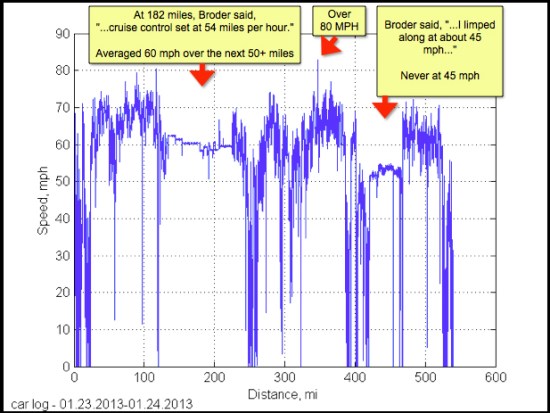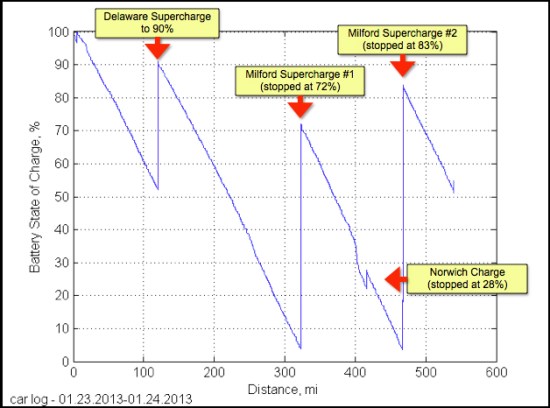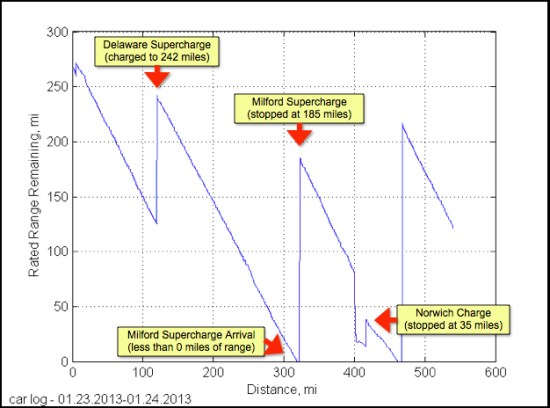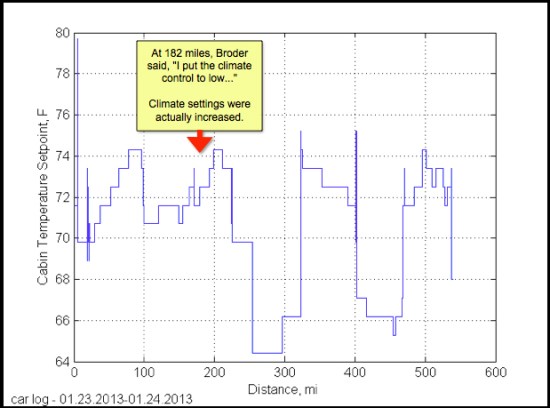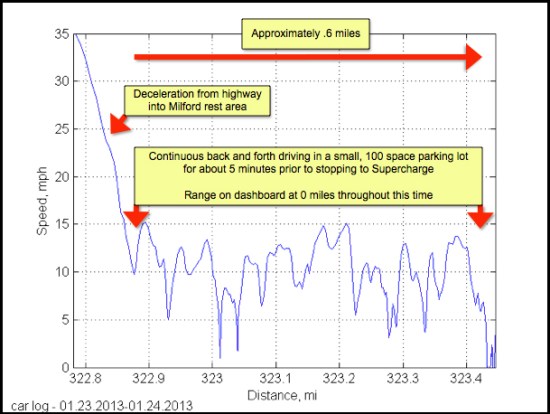In case you weren’t already aware, Tesla Motors’ Elon Musk and The New York Times‘ John M. Broder have been involved in something of a brouhaha ever since Broder published a rather damning evaluation of Tesla’s Supercharger network, and therefore their Model S electric vehicles, on the East Coast last Friday. Essentially, Musk and Tesla contend that Broder essentially sabotaged his own review, and Broder argues that everything he did during the review was justified. Musk has since come forward with a whole mess of data on the trip, but the reality of the situation is still rather murky.
To put it bluntly, Broder’s evaluation pretty much dumps on the entire experience. From claiming that the car kept threatening to run out of juice to his having to get a flatbed truck just to return to a charging station when it finally did, he doesn’t paint a pretty picture. It reads like a cautionary tale, and is titled “Stalled on the E.V. Highway.” It’s pretty obvious what Broder thinks about the trip.
But Musk’s recent blog post paints a different series of events. Here’s a bulleted list directly from said blog of all the specific accusations they make against Broder’s own claims:
- As the State of Charge log shows, the Model S battery never ran out of energy at any time, including when Broder called the flatbed truck.
- The final leg of his trip was 61 miles and yet he disconnected the charge cable when the range display stated 32 miles. He did so expressly against the advice of Tesla personnel and in obvious violation of common sense.
- In his article, Broder claims that “the car fell short of its projected range on the final leg.” Then he bizarrely states that the screen showed “Est. remaining range: 32 miles” and the car traveled “51 miles,” contradicting his own statement (see images below). The car actually did an admirable job exceeding its projected range. Had he not insisted on doing a nonstop 61-mile trip while staring at a screen that estimated half that range, all would have been well. He constructed a no-win scenario for any vehicle, electric or gasoline.
- On that leg, he drove right past a public charge station while the car repeatedly warned him that it was very low on range.
- Cruise control was never set to 54 mph as claimed in the article, nor did he limp along at 45 mph. Broder in fact drove at speeds from 65 mph to 81 mph for a majority of the trip and at an average cabin temperature setting of 72 F.
- At the point in time that he claims to have turned the temperature down, he in fact turned the temperature up to 74 F.
- The charge time on his second stop was 47 mins, going from -5 miles (reserve power) to 209 miles of Ideal or 185 miles of EPA Rated Range, not 58 mins as stated in the graphic attached to his article. Had Broder not deliberately turned off the Supercharger at 47 mins and actually spent 58 mins Supercharging, it would have been virtually impossible to run out of energy for the remainder of his stated journey.
- For his first recharge, he charged the car to 90%. During the second Supercharge, despite almost running out of energy on the prior leg, he deliberately stopped charging at 72%. On the third leg, where he claimed the car ran out of energy, he stopped charging at 28%. Despite narrowly making each leg, he charged less and less each time. Why would anyone do that?
- The above helps explain a unique peculiarity at the end of the second leg of Broder’s trip. When he first reached our Milford, Connecticut Supercharger, having driven the car hard and after taking an unplanned detour through downtown Manhattan to give his brother a ride, the display said “0 miles remaining.” Instead of plugging in the car, he drove in circles for over half a mile in a tiny, 100-space parking lot. When the Model S valiantly refused to die, he eventually plugged it in. On the later legs, it is clear Broder was determined not to be foiled again.
Given that Tesla monitors all data for media drives, specifically started after an inaccurate Top Gear segment, it’s hard to argue with the facts they present. We’d have normally clipped some of the bulleted items above, but they’re all noteworthy and most build on previous items. It’s a pretty huge accusation of what amounts to outright fraud. For their part, The New York Times will supposedly be responding — though it’ll likely be from Broder — to the accusations today, but it’s hard to say what exactly they’re going to offer.
Musk’s blog also includes a series of images that seem to further indicate that Broder intentionally sabotaged his ride:
On the other hand, of course this is what Tesla is going to say. It’s not like they’re going to take any of this without responding. They’re going to go to the data they’ve collected and cherry-pick whatever makes them look good. That’s the response many have given to Musk’s data so far, but it’s hard to argue with the facts being presented when it certainly looks like a number of claims made by Broder were misleading at best.
(via Tesla Motors, images courtesy of Tesla Motors)
- Traditional auto dealers claim that Tesla stores are illegal
- Tesla’s Supercharger network is still pretty new
- SpaceX is doing good things



